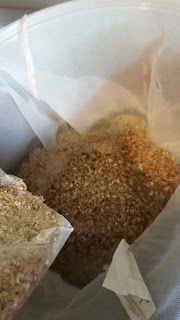 So I've been thinking. What are the 10 essential styles every home brewer should be able to do well? What should you master before you attempt a continuously hopped imperial sour stout with bretomyces and dragon fruit puree? Not that there is anything wrong with experimental brewing. I am a fan of Denny Conn and Drew Beechum. But, before you run, you should really be able to walk. Notice here I am not talking about process type here. This isn't an extract vs all grain post. I know extract brewers who make amazing beer. This is about understanding styles.
So I've been thinking. What are the 10 essential styles every home brewer should be able to do well? What should you master before you attempt a continuously hopped imperial sour stout with bretomyces and dragon fruit puree? Not that there is anything wrong with experimental brewing. I am a fan of Denny Conn and Drew Beechum. But, before you run, you should really be able to walk. Notice here I am not talking about process type here. This isn't an extract vs all grain post. I know extract brewers who make amazing beer. This is about understanding styles.
What beer is the measuring stick? The process checker?
Here are my 10, and my process checker.
1. Pale ale - just a good basic pale ale
2. Wheat Beer - good basic wheat is the base of so much fruit and sour
3. Brown ale - dark and sweet and yummy a gateway beer
4. American amber - cause you know amber
5. American ipa - who doesn't love a hop monster
6. Cream ale - this is the beer your BMC friends will love
7. Stout - (and preferably with some sour included)
8. Ale temperature lager - ( my champagne lager recipe is at brewtoad)
9. A fruit beer - hot chicks need beer too
10. A honey beer - my personal favorite is honey brown
2. Wheat Beer - good basic wheat is the base of so much fruit and sour
3. Brown ale - dark and sweet and yummy a gateway beer
4. American amber - cause you know amber
5. American ipa - who doesn't love a hop monster
6. Cream ale - this is the beer your BMC friends will love
7. Stout - (and preferably with some sour included)
8. Ale temperature lager - ( my champagne lager recipe is at brewtoad)
9. A fruit beer - hot chicks need beer too
10. A honey beer - my personal favorite is honey brown
 |
| Cream ale is one of my favorite styles to make and drink. Even SWMBO will drink it cold. |
My control beer is cream ale. If there's anything wrong with your process, the cream ale will expose your flaws. If you can't brew a clean crisp cream ale, then you need to work on your process. Not hide flaws with mega hop additions. Just saying. Not that there is anything wrong with mega hop additions. But if you can't brew a nearly competitively perfect cream ale? what is the problem in your process? Although I will say with cream ale, you can taste it prior to bottling, if you do have a flawed beer, you can add a hop tea and dry hop it for a couple of days... boom American IPA. One of my favorites ever was a beer that had too much estery flavors. (I tried a cream ale with an english ale yeast) I threw the kitchen sink into dry hops and created a great cream IPA that we dubbed the "creamy indian".
I'd love to hear your 10...
 |
| Pliny the toddler, Yum! |
A note in closing. I have been researching extract vs all grain recently. Most of the experiments, and exbeeriments I have seen, the extract actually won. Leading me to the conclusion that brewing with at least some extract may actually be a superior method. The only draw back is the lack of base grains available in extract. Im not aware of a Vienna, or Munich malt extract. It seems that the malt companies may be better at extracting sugar from grains than we are... hmmm who would have guessed it. Just another feather in the cap of partial mash brewing. Ill be posting links soon when I reach some real conclusions. I'll still do loads of small all grain batches. They are just too much fun to stop, and the beer turns out great. But it does make you wonder.


















